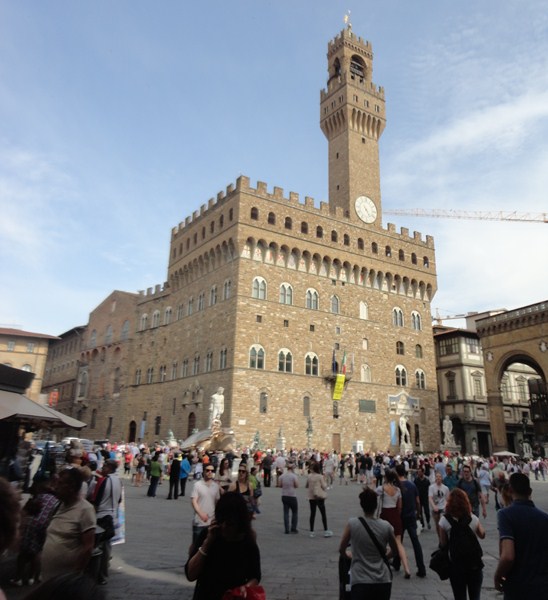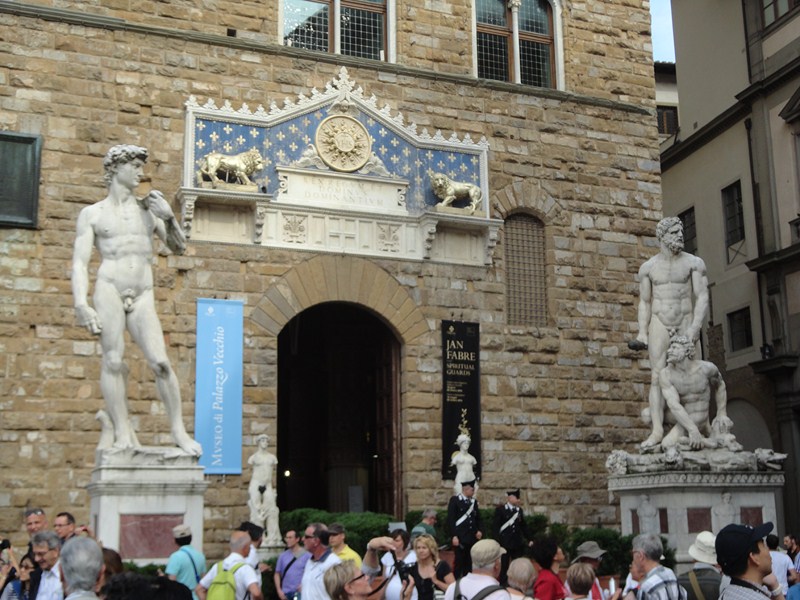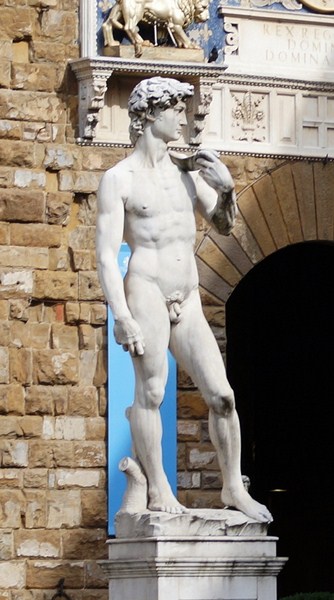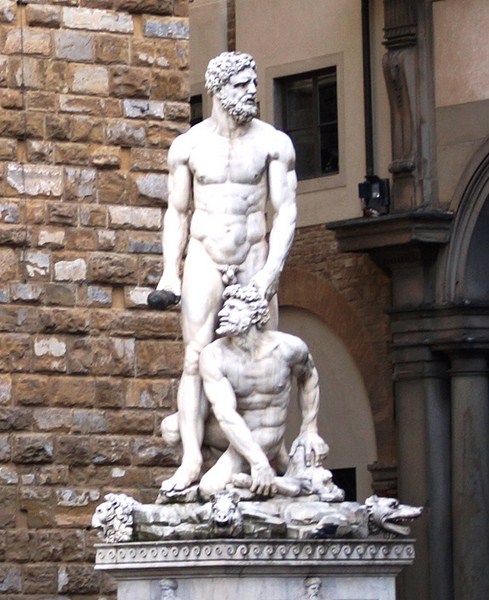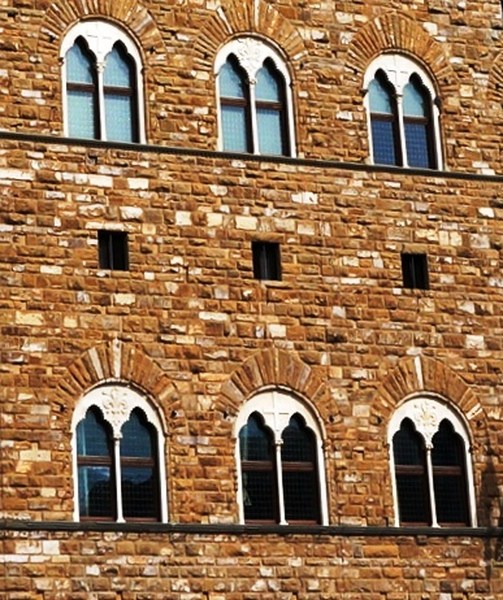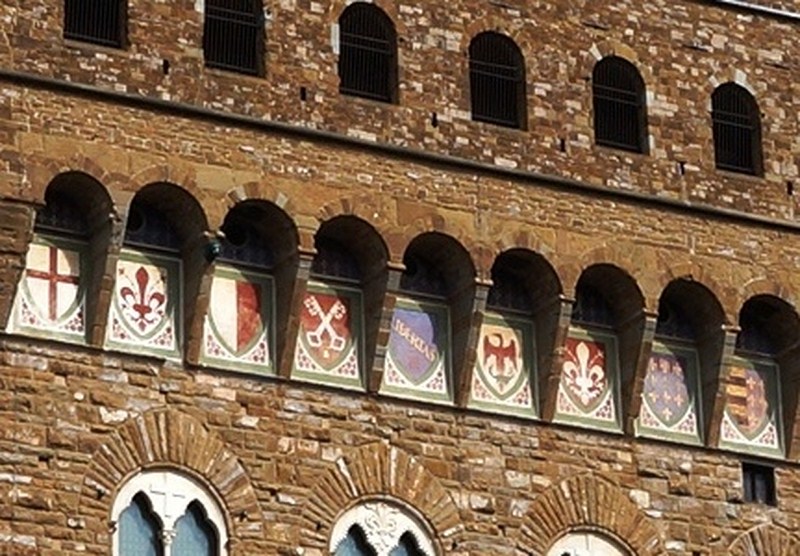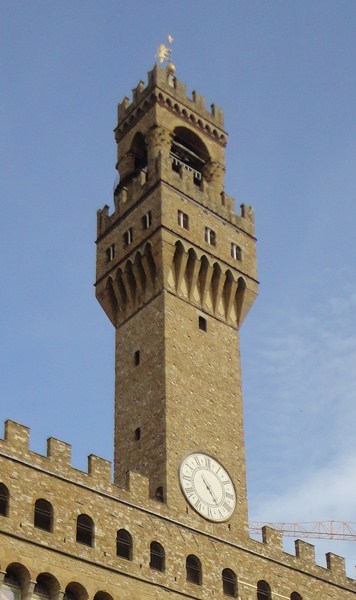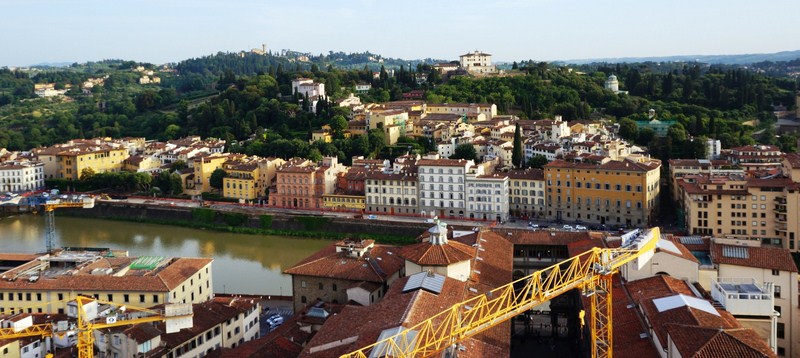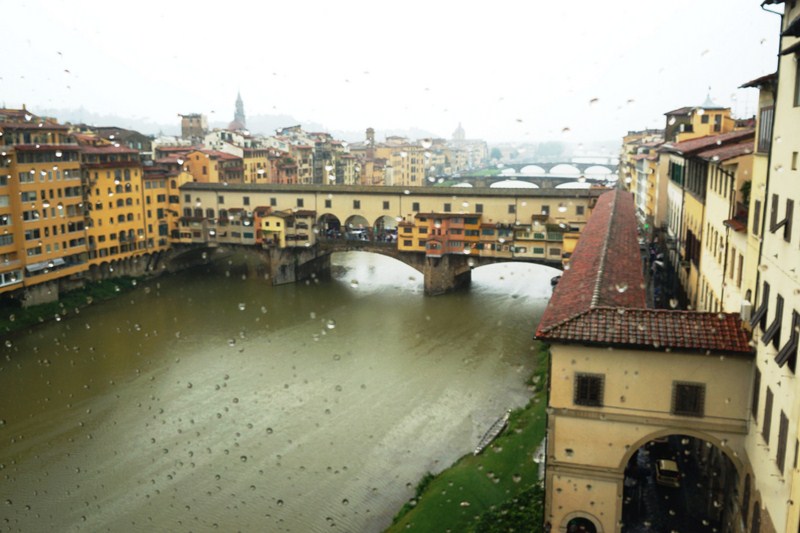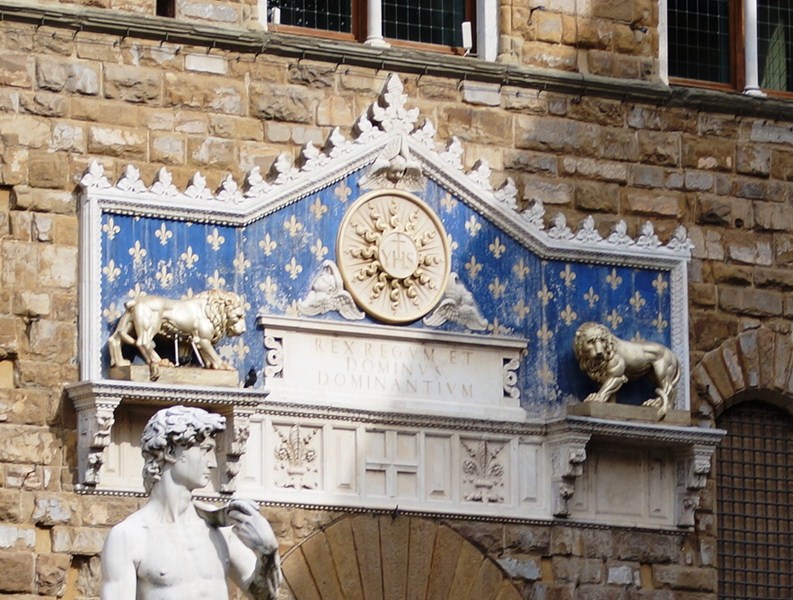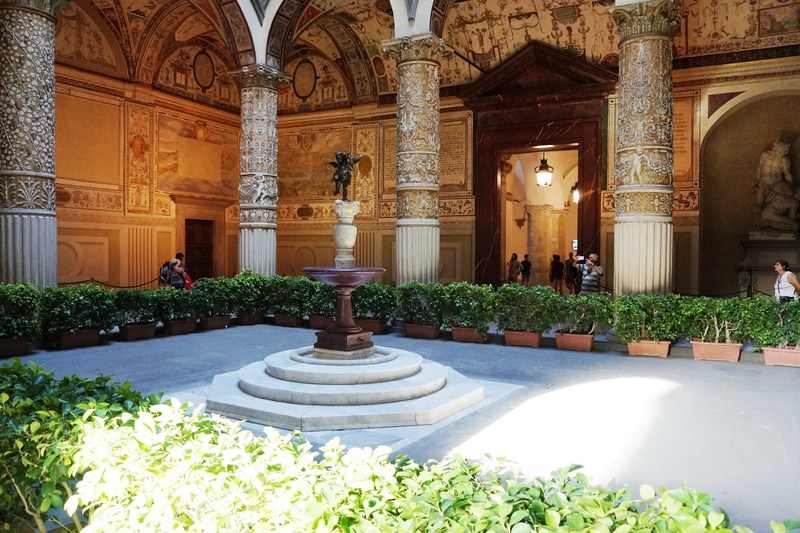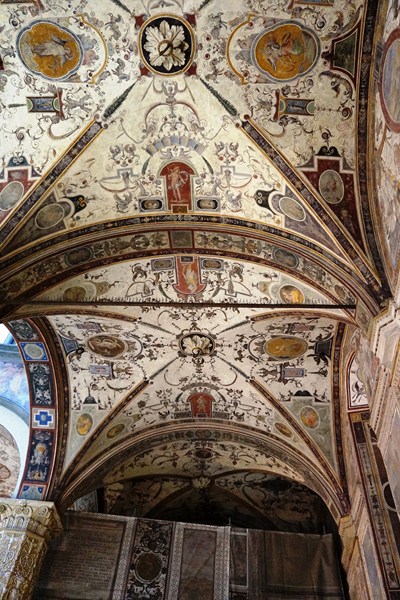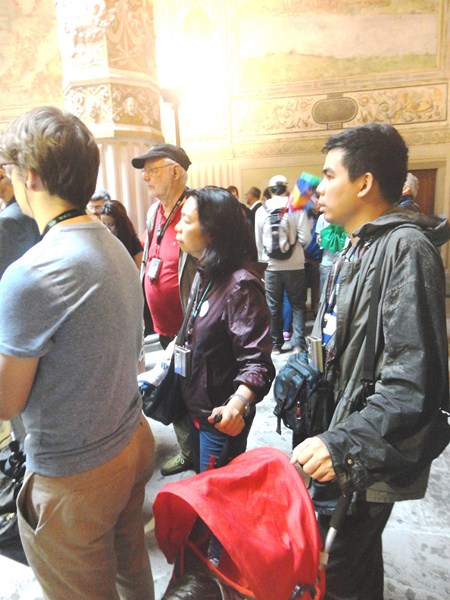The Palazzo Vecchio, the town hall of Florence, overlooks the Piazza della Signoria. Its entrance is flanked by a copy of Michelangelo‘s David statue (erected in 1910, the original once stood at the entrance from its completion in 1504 to 1873, when it was moved to the Accademia Gallery) and Baccio Bandinelli‘s statue of Hercules and Cacus.
Check out “Gallerie dell’Accademia”
Originally called the Palazzo della Signoria (after the Signoria of Florence, the ruling body of the Republic of Florence), it was, in accordance with the varying use of the palace during its long history, also called the Palazzo del Popolo, Palazzo dei Priori and Palazzo Ducale. After the Medici duke’s residence was moved, across the Arno River, to the Palazzo Pitti, the building acquired its current name.
When Cosimo later removed to Palazzo Pitti, he officially renamed the Palazzo della Signoria, his former palace, to the Palazzo Vecchio (“Old Palace”), although the adjacent town square, the Piazza della Signoria, still bears the original name. Although most of it is now a museum, the Palazzo Vecchio remains as the symbol and center of local government.
Here is the historical timeline of the palace:
- In 1299,the Florentine commune and people decided to build a palace that would be worthy of the Florence’s importance and, in times of turbulence, would be more secure and defensible for the magistrates of the commune. Construction was begun by Arnolfo di Cambio (the architect of the Duomo and the Santa Croce church) upon the ruins of Palazzo dei Fanti and Palazzo dell’Esecutore di Giustizia once owned by the Uberti family.
- In 1353, the clock of the Torre d’Arnolfo was constructed by the Florentine Nicolò Bernardo.
- In the 15th century,Michelozzo Michelozzi added decorative bas-reliefs of the cross and the Florentine lily in the spandrels between the trefoil arches of the windows.
- In 1494, the Salone dei Cinquecento chamber was built.
- In May 1540, Duke Cosimo I de’ Medici (later to become grand duke) moved his official seat, from the Medici palazzo in Via Larga, to the Palazzo della Signoria, signaling the security of Medici power in Florence.
- In 1565, the frescoes at the first courtyard were painted by Giorgio Vasari for the wedding celebration of Francesco I de’ Medici (the eldest son of Cosimo I de’ Medici) to Archduchess Johanna of Austria (sister of the Emperor Maximilian II).
- Between 1555 and 1572, the surviving decorations were made by Giorgio Vasari and his helpers, among them Livio Agresti from Forlì. They mark the culmination of Mannerism and make this hall the showpiece of the palace.
- In 1667, the tower clock was replaced with a replica made by Georg Lederle from the German town of Augsburg (Italians refer to him as Giorgio Lederle of Augusta) and installed by Vincenzo Viviani.
- From 1865–71, at a moment when Florence had become the temporary capital of the Kingdom of Italy, the palace gained new importance as the seat of united Italy’s provisional government.
- Since 1872, it has housed the office of the mayor of Florence and is the seat of the City Council.
The solid, massive and cubical building, made of solid rusticated stonework, has two rows of two-lighted Gothic windows, each with a trefoil arch, and is crowned with a projecting crenellated battlement supported by small arches (under which are a repeated series of nine painted coats of arms of the Florentine republic) and corbels.
Some of these arches are used as embrasures (spiombati) for dropping heated liquids or rocks on invaders.
The simple, 94 m. high rectangular Torre d’Arnolfo (named after its designer Arnolfo di Cambio) has a large, one-handed clock.
Arnolfo di Cambio incorporated the ancient tower (then known as La Vacca or “The Cow”) of the Foraboschi family into the new tower’s facade as its substructure (this is why the tower is not directly centered in the building). The tower currently has three bells, the oldest cast in the 13th century.
During our visit, we climbed the 418 steps to the top of the tower where we had 360 degree views of the city. We entered via the museum. On our way up, we passed the “Little Hotel,” two small cells that, at different times, imprisoned Cosimo de’ Medici (the Elder) (1435) and Girolamo Savonarola (1498).
No more than 35 people can enter at once and, on busy days, you’ll be limited to 30 minutes. In bad weather, it’s closed.
The Vasari corridor, an above-ground walkway commissioned to Giorgio Vasari by Cosimo I, was built from the Palazzo Vecchio, through the Uffizi (where Cosimo I moved the seat of government), over the Ponte Vecchio to the Palazzo Pitti.
Check out “Palazzo Pitti – Vasari Corridor”
A notable ornamental marble frontispiece, above the front entrance door, dates from 1528. The Monogram of Christ, in the middle, is flanked by two gilded lions. The text (in Latin) above, dating from 1851 (it does not replace an earlier text by Savonarola as mentioned in guidebooks), reads Rex Regum et Dominus Dominantium (“King of Kings and Lord of Lords”).
Between 1529 and 1851, this text was concealed behind a large shield with the grand-ducal coat of arms.
The first courtyard, designed in 1453 by Michelozzo, has harmoniously proportioned columns which, at one time, were smooth and untouched, were at the same time richly decorated with gilt stuccoes. High around the courtyard are lunettes with crests of the church and city guilds while frescoes on the walls are vedutes, some damaged over the course of time, of the cities (Graz, Innsbruck, Linz, Vienna, Hall in Tirol, Freiburg im Breisgau, Konstanz, etc.) of the Austrian Habsburg monarchy. The barrel vaults are furnished with grotesque decorations.
In the center of the courtyard is a porphyry fountain by Battista del Tadda. On top of the fountain’s basin is the Putto with Dolphin, a copy of the original small statue by Andrea del Verrocchio (1476), originally placed in the garden of the Villa Medici at Careggi but now on display on the second floor of the palace. Flowing through the nose of the dolphin is water brought here by pipes from the Boboli Gardens. In front of the fountain is a niche with Samson and Philistine by Pierino da Vinci.
Check out “Palazzo Pitti – Boboli Gardens”
The massive pillars, in the second courtyard (also called Dogana or “Customs Courtyard”), were built in 1494 by Cronaca to sustain the great, most imposing 52 m. (170 ft.) long and 23 m. (75 ft.) wide “Salone dei Cinquecento” on the second floor.
The massive and monumental stairs by Giorgio Vasari, between the first and second courtyard, lead up to the Hall of the Five Hundred (Salone dei Cinquecento). The third courtyard was used mainly for offices of the city.
Check out “Palazzo Vecchio – Hall of the Five Hundred”
The Studiolo of Francesco I (a studiolo is a small study), a small side room, without windows, situated at the end of the hall, was also designed by Giorgio Vasari (1570–1575) in a Mannerist style. Paintings, stucco and sculptures fill the walls and the barrel vault and Baroque paintings hide secret cupboards. Most paintings, representing the four elements (water, fire, earth and air), are by the School of Vasari. The portrait of Cosimo I and his wife Eleonora of Toledo was made by Bronzino while the delicate bronze sculptures were made by Bartolomeo Ammanati and Giambologna. The latter, dismantled within decades of its construction, were re-assembled in the 20th century.
Check out “Palazzo Vecchio – Apartments of the Priors” and Palazzo Vecchio – Apartments of Leo X”
Normally, the Quartieri monumentali (Residence of the Priors and the Quarters of Leo X), the other rooms on the first floor, are not accessible to the public as they are used by the mayor as offices and reception rooms but, probably it was past office hours, it was opened during our visit. A staircase, designed by Giorgio Vasari, led us to the second floor where we visited the Chapel of Signoria, the Hall of Justice (Sala delle Udienze), the Room of the Lilies (Sala dei Gigli), the Study Room and the Apartments of the Elements (Sala degli Elementi).
Check out “Palazzo Vecchio – Apartments of the Elements,” and “Palazzo Vecchio – Apartments of Eleonora”
Palazzo Vecchio: Piazza della Signoria, Florence, Italy. Tel: +39 055 276 8325. Open daily, 9 AM – 7 PM (except Thursdays, 9 AM – 2 PM). Admission: €6.00. Combined ticket with Cappella Brancacci: €8.00

